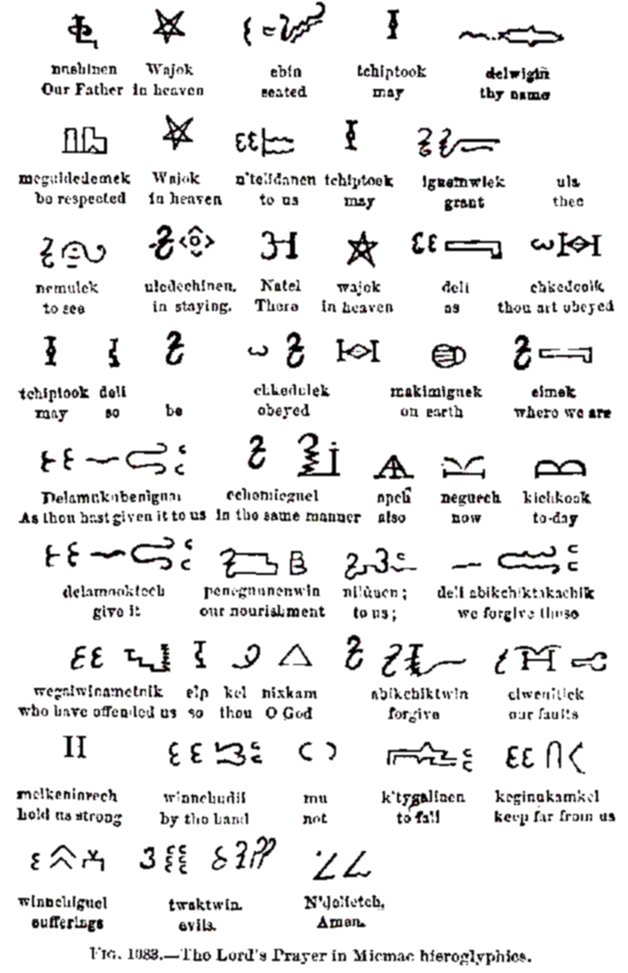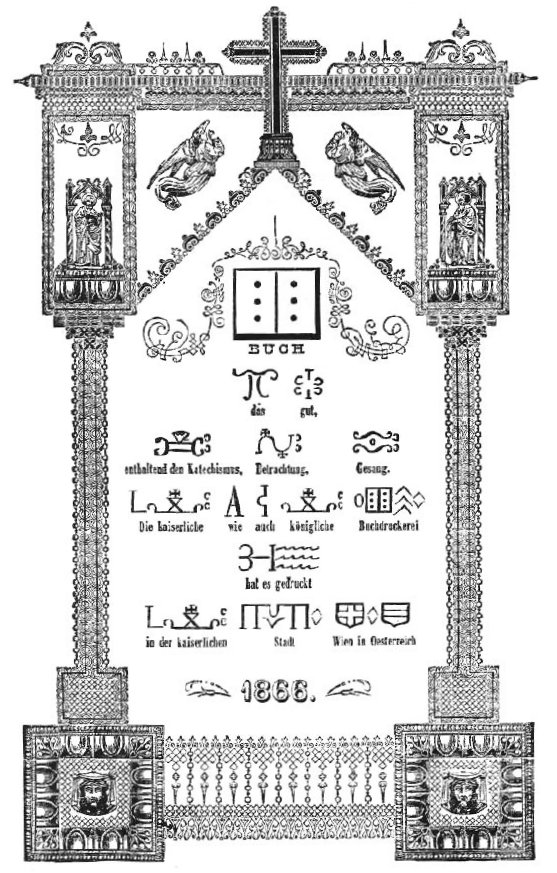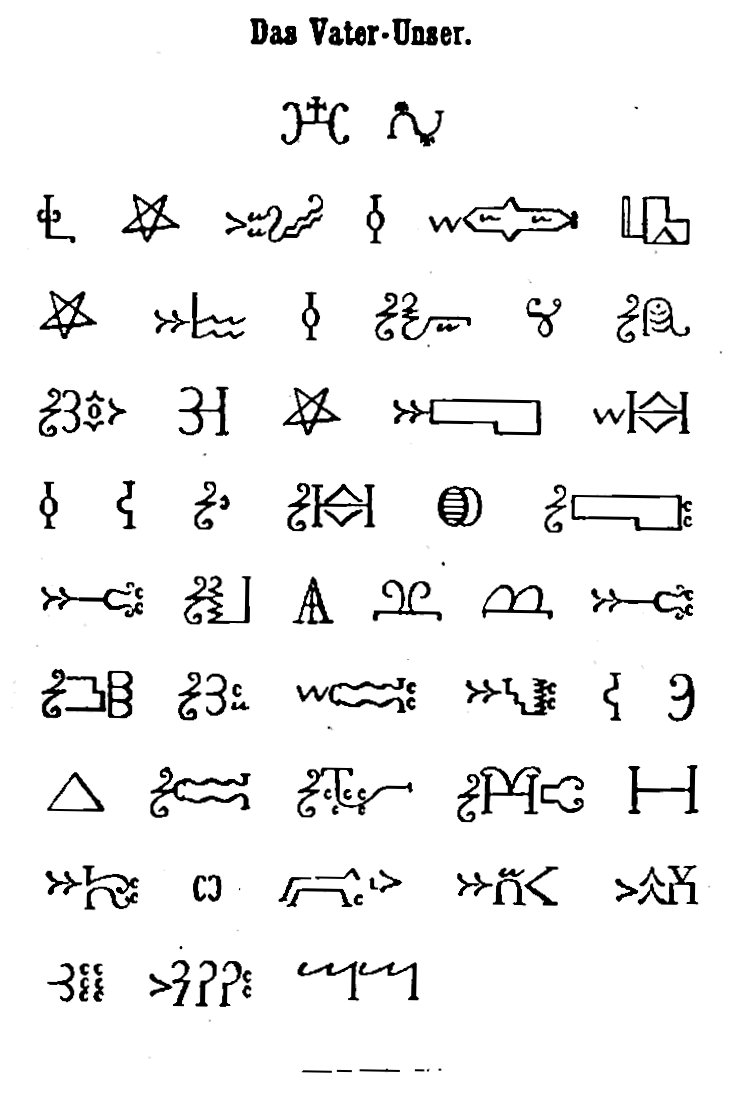|
ABOUT MI'KMAW 'HIEROGLYPHICS'
Right at the start, let's talk about the term 'hieroglyphics,' which is
used so commonly to refer to the Mi'kmaw written symbology. The word is
defined as 'figure of an object standing for a word, syllable or sound, as used in ancient Egyptian and other writing..." (Concise Oxford Dictionary, Seventh
Edition.) The term hieroglyph is therefore inappropriate, since it refers to a one-to-one correlation between a glyph and a word, syllable or sound. More importantly, the word's association with Egyptian writing leads to a misinterpretation of what Mi'kmaw symbols represent. A more appropriate term is 'ideogram', defined as a "...character symbolizing idea of a thing without expressing the sequence of sounds in its name." With ideograms, each character represents a concept, which may be orally expressed with one or many words.
So where did these ideograms come from? Some argue that European missionaries must have invented the system in its entirety, because pre-contact Aboriginal people are perceived as being illiterate.
In most cases, though, the missionaries created a phonetic representation of
an aboriginal language using the Roman characters they are familiar with,
as did Silas Rand. Why, then,
in cases where the people have a tradition of a written language, did the missionaries 'invent' a system of odd symbols that are not based on anything European?
In fact, the existence of the Mi'kmaw ideograms and their development as a teaching tool was documented by the missionaries of the day. The timeline goes something like this:
In 1652,
Father Gabriel Druillettes, a Jesuit
missionary to the Abenaki, reports seeing the Mi'kmaq use ideograms
to record lessons in the "Jesuit Relations" of that year:
"Some of them wrote out their lessons in their
own manner. They made use of a small piece of charcoal instead of a pen,
and a piece of bark instead of paper. Their characters are novel, and so
individual that one could not know or understand the writing of the other;
that is to say, that they made use of certain marks according to their own
ideas as of a local memory to preserve the points and the articles and the
maxims which they had remembered. They carried away this paper with them
to study in the repose of the night."
In 1677
Father Chrétien Le
Clercq, a Franciscan Récollet,
made note in his journals of observing Mi'kmaq children taking notes using charcoal and
birch bark as he was teaching them prayers. Seeing this as an opportunity for more effective teaching,
Father Le Clercq, an accomplished linguist, learned the ideogrammatic system, and expanded it with Mi'kmaw-esque symbols to express
Judeo-Christian concepts that had no representation in the Mi'kmaw
symbology. In 1691 he published "Nouvelle relation de la Gaspésie" in Paris, wherein he discusses his development of this writing
system:
"... our Lord inspired me with the idea of them the
second year of my mission, when being much embarrassed as to the method by which I should teach the Indians to pray to God, I notice that some children were making marks with charcoal upon birch-bark, and were counting these with the finger very accurately at each word of prayers which they pronounced. This made me believe that by giving them some formulary, which would aid their memory by
definite characters, I should advance much more quickly than by teaching them through the method of making them repeat a
number of times that which I said to them. They preserve these instructive papers with so much care, and they have for them so particular an esteem, that they keep them very neatly in little cases of
birch-bark bedecked with wampum, with beadwork, and with porcupine quills."
In 1738,
l'Abbé
Pierre-Antoine-Simon Maillard (French Seminary of Foreign Missions) also worked out the Mi'kmaw symbols, and published a grammar of the language.
It appears that his work was independent of
Le Clercq's, and Maillard devoted 8 years to the task.
In 1791, Midshipman John Thomson of HMS Fly collected a copy of the Lord's Prayer and The Apostle's Creed in Mi'kmaw
ideograms, done on birch bark, from Mi'kmaw people in Newfoundland. He
sent these items to Sir Joseph Banks, president of the Royal Society of
London, and they are now held by the British
Museum. His cover letter read:
His Majesty's Sloop Fly,
Plymouth Sound, 13th November '91
Sir-
I beg leave herewith
enclosed to send you the Lord's Prair & Creed, written by the Native
Indians of Newfoundland, which they did it with a stick made in the
shape of a pen. The Creed marked Number One, the Prair No. 2. I beg
leave, Sir, to observe it the Roman Catholic Prair & Creed, as the
Frenchmen have intermarried with those Indians.
I have the honor to be
Sir,
Your very humble servant
John Thomson, Midshipman
HMS Fly
[To] Sir Joseph Banks
Sir-
I this day had the Honor of your favour, and beg leave in reply to
Acquaint you that it was wright by those Indians; and Sir they have
amongst them a Schoolmaster to instruct their children in Wright and
read, and on my making a Penn for them they prefer'd the Stick.
There is in every family a large Book made out of the Bark of the
Birch tree written I should suppose Century back. If these
informations is of any Service, it will give much Pleasure. I beg to
observe, I offered any price for one of these Books, but they would
not part with them upon any account... I have the Honor to be Sir,
Your most obedient
John Thomson
Source:
British Library, Add. ms. 11038, fo. 13-16.
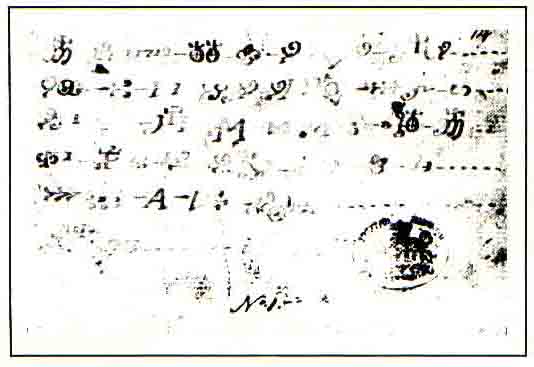 |
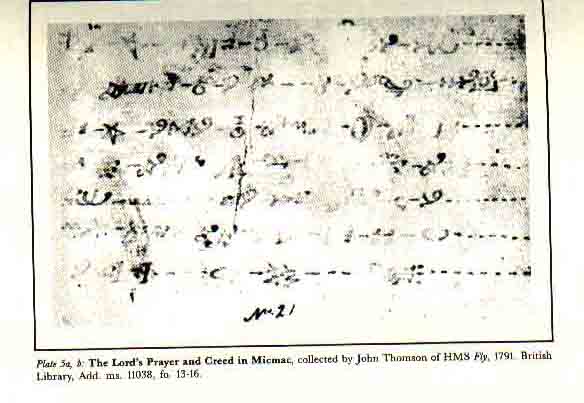 |
|
Midshipman John Thomson's ideogrammatic prayers (click
for larger views) |
In 1857,
Father Eugene Vetromile (Society of Jesuits), well-versed in the languages, publishes his
"Indian Good Book." (1) In 1866, he also publishes "The
Abenakis", wherein he discusses existence of written manuscripts held by medicine people:
"Several Indians possessed (in the time of the first French missions) in their wigwams, a kind of library, composed of stones and of pieces of bark, and the medicine men had large manuscripts of these peculiar characters, which they read over the sick persons... The Indians assert that by these signs they could express any idea with every modification, just as we do with our writings."
Also in 1866, Father Vetromile persuades seminary friend and missionary neighbor Rev. Christian
Kauder, a Redemptorist, to publish a collection of prayers, songs and catechisms in the Mi'kmaw
ideograms, entitled "Buch das gute." (2) The publication of
Rev. Kauder was in three parts: Catechism, 144 pages; religious reflections, 109 pages; and hymnal, 208 pages. On careful examination of the symbols, one can distinguish between some of the original Mi'kmaw symbols, each of which represented mnemonically a whole sentence or verse, and a large number of arbitrary designs that have been added to express ideas and words which were not
Native American. For example, the symbol for Niskam (God) is a triangle, representing the holy trinity, and three other ideograms incorporating the triangle are used to represent the Father, Son and Holy Spirit. Many odd
curlicues were incorporated with the symbols, intended to represent the
peculiarities of the Mi'kmaw grammar as understood by Rev. Kauder. An example from this document is reproduced below.
The book was
re-released in 1921 by the Micmac Messenger organization.
Finally, in 1921, Father Pacifique (Henri Buisson d’Valigny,)
a Capuchin missionary who was extremely well-respected by the Mi'kmaq,
publishes "Manual of Prayers, Introductions, Problems, and Hymns in
Micmac Ideograms" in Restigouche, Quebec. While this document has
earned Father Pacifique the reputation of having invented the writing
system, it is in fact a re-issue of Kauder's book in French. Pacifique was
apparently taught to read the symbols in 1900 by Peter Paul Denny Sr. at
Chapel Island, NS. However, to his credit it should be noted that Father
Pacifique did develop his own orthography, which is still in use in New
Brunswick, and he also published many books for
the Mi'kmaq, including an extensive grammar in 1939.
So what happened to the ideograms? Apparently, a
written language was not that useful to the Mi'kmaq, being a primarily
oral culture. Various sources have said that the Mi'kmaq would
occasionally leave notes in a marker beside a trail for followers, or
record information for future reference. However, the ideograms were not a
major part of their life, and consequently the knowledge of their use has
been lost with assimilation. It should be mentioned
that there are also knowledgeable people within the Mi'kmaq community
that do not believe in a pre-existing writing system. Dr Bernie Francis,
an acknowledged expert on the subject of the Mi'kmaw language and
co-creator of the Smith-Francis orthography, does not believe a
workable, wide-spread writing system was used prior to the arrival of
Europeans. In his own words:
"Cartier’s arrival with
his crew in 1534 do not make a startling discovery in that these
'Indians' have their own writing system. Champlain’s arrival in 1606
with his crew make no mention of it either to any degree that I know
of.
"Of course, our people were writing, but it wasn’t a 'writing
system.' Our people wrote rudimentary marks/symbols as memory aids
for themselves when learning something new. However, they could not
pass on these marks to someone else for their reading pleasure. The
missionaries stated that.
"Our people not only did not have, but did not NEED a 'writing
system.' All one needs to do is to check on the comments that were
made about our memories. If anyone wishes to boast about our people
of the past then boast about their phenomenal memories and NOT a
non-existent writing system."
|



